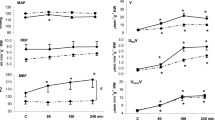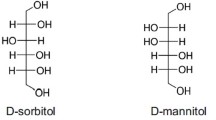Summary
-
1.
In unanaesthetized rats with indwelling catheters simultaneous infusions of water and 1.8% NaCl solution are performed at equal rates into the portal vein and the V. cava inferior respectively. At the chosen small rate of infusion a very pronounced diuretic reaction is observed in this case. Reversal of the infusion sites (1.8% NaCl into the V. portae; water into the V. cava) leads to a transient antidiuresis.
-
2.
Small amounts of hypertonic solutions injected alternately into the portal vein and inferior vena cava have an antidiuretic effect only when administered intraportally.
-
3.
Intraportal infusions carried out with sodium free solutions show that the diuretic response mediated by the liver osmoreceptors is indirectly proportional to the osmolar concentration of the infused solution.
-
4.
The diuretic response to an infusion of water into the abdominal aorta is quantitatively and qualitatively similar to that of an intracaval infusion.
-
5.
Variation of the portal hepatic blood flow of the conscious animal from 4–12 ml/min by means of an extracorporal portocaval shunt has no effect upon urinary flow rates.
-
6.
The results confirm the existence of specific osmoreceptors in the liver. Their adequate stimulus is a change of the osmolar concentration of the portal blood. They are active in both the hypo- and the hypertonic range. They influence urinary secretion prior to significant changes in the osmolarity of systemic blood, thus occupying the primary position in osmoregulatory processes, before the cerebral osmoreceptors (Verney) become involved.
Zusammenfassung
-
1.
An wachen Ratten mit einoperierten Gefäßkathetern wird gleichzeitig und mit gleicher Geschwindigkeit in die V. portae und V. cava caud. Wasser bzw. 1,8% NaCl-Lösung infundiert. Bei der gewählten relativ kleinen Infusionsrate tritt nur im Falle der Infusion von Wasser in die V. portae und gleichzeitig 1,8% NaCl-Lösung in die V. cava caud. eine starke Steigerung der Diurese auf, während bei vertauschten Lösungen, d. h. Wasser in die V. cava caud. und 1,8% NaCl in die V. portae eine vorübergehende Antidiurese beobachtet werden kann.
-
2.
Kleine Mengen hypertoner Lösung, intraportal bzw. intracaval injiziert, haben nur im ersten Falle eine antidiuretische Wirkung (Verney-Versuch an der V. portae).
-
3.
Auch bei Infusionen von Na-freien Lösungen in die V. portae läßt sich die diuretische Aktivität über die Osmoreceptoren der Leber auslösen und abstufen.
-
4.
Infusionen von Wasser in die Aorta abdominalis und V. cava haben hinsichtlich der diuretischen Aktivität die gleiche Wirkung.
-
5.
Wird beim wachen Tier durch einen extracorporalen portocavalen Shunt die Leberdurchblutung von 4–12 ml/min variiert, so ist dies ohne Einfluß auf die Diurese.
-
6.
Die Ergebnisse bestätigen die Existenz von spezifischen Osmoreceptoren in der Leber. Ihr adäquater Reiz ist die osmotische Konzentration des Portalblutes. Sie arbeiten sowohl im hypo-wie hypertonen Bereich und beeinflussen die Urinsekretion zu einem Zeitpunkt, an dem die Osmolarität des Gesamtblutes noch unverändert ist. Sie sind den cerebralen Osmoreceptoren (Verney) vorgeschaltet.
Similar content being viewed by others
Literatur
Arndt, J. O., Gauer, O. H.: Diuresis induced by water infusion into the carotid loop of unanaesthetized dogs. Pflügers Arch. ges. Physiol.282, 301 (1965).
Aziz, O., Haberich, F. J., Nowacki, P. E.: Technik der Dauerkatheterisierung der Vena portae und Vena cava caudalis an der wachen Ratte. Naturwissenschaften51, 557 (1964).
Aziz, O., Nowacki, P. E., Haberich, F. J.: Abstufbarkeit der hepatogenen Diurese durch natriumfreie Lösungen. Pflügers Arch. ges. Physiol.289, R87 (1966).
Gauer, O. H., Henry, J. P.: Beitrag zur Homöostase des extraarteriellen Kreislaufs. Volumenregulation als unabhängiger physiologischer Parameter. Klin. Wschr.34, 356 (1956).
——: Circulatory basis of fluid volume control. Physiol. Rev.43, 423 (1963).
Haberich, F. J.: Osmoreception in the portal circulation. Fed. Proc.27, 1137 (1968).
—, Aziz, O., Nowacki, P. E.: Über einen osmoreceptorisch tätigen Mechanismus in der Leber. Pflügers Arch. ges. Physiol.285, 73 (1965).
———: Das Verhalten von Blutdruck und Diurese bei kurzfristigen Abklemmungen der Vena portae. Pflügers Arch. ges. Physiol.288, 151 (1966).
———: Flüssigkeitsspeicherung in der Leber nach enteraler Wasserresorption. Pflügers Arch. ges. Physiol.288, 306 (1966).
——, Ohm W.: Untersuchungen zur Spezifität des Osmoreceptors in der Leber. Pflügers Arch. ges. Physiol.294, 36 (1967).
—, Dennhardt, R., Ohm, W.: Die Ausschaltung der Leberäste des N. vagus an der wachen Ratte und ihr Einfluß auf die hepatogene Diurese. Pflügers Arch.307, 80 (1969).
Kuzmin, B. L.: (Osmo- und Natriorezeptoren des kleinen Kreislaufs) russ. Fiziol. Zh. (Kiev)50, 603 (1964).
Ohm, W., Aziz, O., Haberich, F. J.: Das Strom-Zeitvolumen im Mesenterialkreislauf wacher Ratten, ermittelt über die Druck-Volumen-Charakteristik des mesenterialen Gefäßbettes. Pflügers Arch. ges. Physiol.294, 9 (1967).
—, Haberich, F. J.: Über den Einfluß des Druckes im Portalkreislauf auf die Diurese der wachen Ratte. Pflügers Arch.306, 227 (1969).
Thurau, K., Schnermann, J.: Die Natriumkonzentration an den Macula densa-Zellen als regulierender Faktor für das Glomerulumfiltrat (Mikropunktionsversuche). Klin. Wschr.43, 410 (1965).
Verney, E. B.: The antidiuretic hormone and the factors which determine its release. Proc. roy. Soc. B135, 25 (1948).
Wolfman, E. F., Zuidema, G. D., O'Neal, R. M., Turcotte, J., Kowalczyk, R., Child, Ch. G.: Sodium excretion after intrasplenic and systemic injections of sodium chloride in normal dogs and after portacaval shunt. Surgery50, 231 (1961).
Author information
Authors and Affiliations
Rights and permissions
About this article
Cite this article
Haberich, F.J., Aziz, O., Nowacki, P.E. et al. Zur Spezifität der Osmoreceptoren in der Leber. Pflugers Arch. 313, 289–299 (1969). https://doi.org/10.1007/BF00593954
Received:
Issue Date:
DOI: https://doi.org/10.1007/BF00593954




